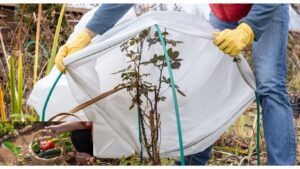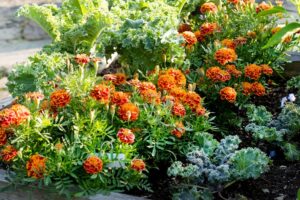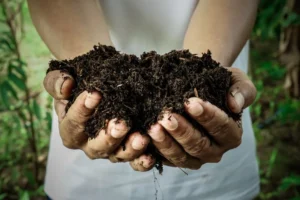Managing pests in an organic garden requires a balanced approach that emphasizes prevention, biodiversity, and the use of natural remedies. Chemical pesticides are off the table, so it’s crucial to employ strategies that protect your plants without harming the environment. In this section, we’ll explore various natural pest control methods to keep your garden healthy and productive.
Encouraging Beneficial Insects
One of the most effective ways to control pests organically is by attracting beneficial insects to your garden. These natural predators help keep pest populations in check without the need for chemical interventions.
- Ladybugs: Known for their appetite for aphids, ladybugs are a gardener’s best friend. A single ladybug can eat up to 50 aphids a day. You can attract ladybugs by planting dill, fennel, and marigolds, which provide nectar and pollen.
- Lacewings: These insects are voracious predators of soft-bodied pests like aphids, caterpillars, and whiteflies. To attract lacewings, plant flowers like yarrow, goldenrod, and cosmos, which provide essential nectar.
- Hoverflies: Often mistaken for bees, hoverflies are excellent at controlling aphid populations. They are attracted to composite flowers like daisies, sunflowers, and zinnias.
- Parasitic Wasps: These tiny wasps are harmless to humans but lethal to garden pests like caterpillars and aphids. Planting herbs like dill, cilantro, and parsley can encourage these beneficial insects to take up residence in your garden.
- Ground Beetles: These nocturnal predators feed on a variety of pests, including slugs, snails, and caterpillars. You can attract ground beetles by maintaining a diverse garden with plenty of ground cover, like mulch or low-growing plants, which provide shelter.
Companion Planting for Pest Control
Companion planting involves growing certain plants together to enhance growth, improve flavor, and deter pests. This technique can significantly reduce pest problems in your organic garden.
- Basil and Tomatoes: Planting basil near tomatoes not only improves the flavor of the tomatoes but also repels aphids, whiteflies, and tomato hornworms.
- Marigolds and Vegetables: Marigolds emit a scent that deters many pests, including nematodes and aphids. Planting marigolds around the edges of vegetable beds can provide a protective barrier.
- Garlic and Roses: Garlic is known to repel aphids, spider mites, and Japanese beetles, making it an excellent companion for roses.
- Onions and Carrots: Onions can help deter carrot flies, while carrots can improve the flavor of onions. This combination also helps maximize garden space.
- Nasturtiums and Brassicas: Nasturtiums attract aphids away from brassicas like cabbage, broccoli, and kale. They also repel whiteflies, making them a great companion plant.
Physical Barriers and Traps
Sometimes, the simplest solutions are the most effective. Physical barriers and traps can prevent pests from reaching your plants or reduce their numbers.
- Row Covers: Lightweight row covers made of fabric or netting can protect plants from a variety of pests, including aphids, flea beetles, and cabbage moths. These covers also provide some protection against frost and can extend your growing season.
- Copper Tape for Slugs and Snails: Slugs and snails dislike crawling over copper because it reacts with their slime, creating an unpleasant sensation. Wrapping copper tape around the bases of pots or raised beds can help keep these pests at bay.
- Sticky Traps: Sticky traps are useful for monitoring and controlling flying insects like whiteflies, aphids, and fungus gnats. Place them near susceptible plants to catch adult pests before they can lay eggs.
- Beer Traps for Slugs: Slugs are attracted to the smell of beer. You can create a simple trap by burying a shallow container filled with beer at soil level. Slugs will crawl in and drown.
- Handpicking: For larger pests like caterpillars, beetles, and slugs, handpicking can be an effective method of control. Visit your garden in the early morning or late evening when these pests are most active, and remove them by hand.
Natural Pest Repellents and Homemade Solutions
Homemade pest repellents and solutions can be just as effective as store-bought options, without the harmful chemicals. Here are a few tried-and-true recipes:
- Neem Oil Spray: Neem oil is a natural insecticide that disrupts the life cycle of pests, preventing them from feeding, molting, and reproducing. To make a spray, mix 2 teaspoons of neem oil with a few drops of liquid soap in a quart of water. Spray on affected plants every 7-14 days.
- Garlic and Chili Spray: Garlic and chili peppers are potent natural repellents. Blend 10 cloves of garlic and 2 hot chilies with a quart of water. Let the mixture steep overnight, strain, and spray on plants to deter aphids, caterpillars, and other pests.
- Soap and Water: A simple soap spray can suffocate soft-bodied pests like aphids, mites, and whiteflies. Mix 1 tablespoon of mild liquid soap with a quart of water and spray directly on the pests.
- Diatomaceous Earth: This natural powder, made from fossilized algae, can be sprinkled around plants to deter crawling insects like slugs, beetles, and ants. The powder’s sharp edges cut through the exoskeletons of insects, causing them to dehydrate.
- Essential Oil Sprays: Essential oils like peppermint, eucalyptus, and rosemary have strong scents that repel pests. Mix 10-15 drops of essential oil with a quart of water and spray around your garden to keep pests at bay.
Maintaining Garden Health to Prevent Pests
A healthy garden is naturally more resistant to pests. By maintaining good gardening practices, you can prevent many pest problems before they start.
- Soil Health: Healthy soil produces healthy plants that are better able to resist pests and diseases. Regularly amend your soil with organic compost and mulch to improve its structure and fertility.
- Proper Spacing: Overcrowded plants are more susceptible to pests and diseases due to poor air circulation. Follow recommended spacing guidelines for each plant to reduce the risk of infestation.
- Regular Monitoring: Regularly inspect your garden for signs of pests. Early detection allows for quick intervention before pests can cause significant damage. Check the undersides of leaves, stems, and soil for signs of eggs, larvae, or damage.
- Crop Rotation: Rotating crops each season helps prevent the buildup of pests and diseases in the soil. Avoid planting the same family of plants in the same spot year after year.
- Cleaning Up Garden Debris: Dead leaves, fallen fruit, and other garden debris can harbor pests and diseases. Regularly clean up debris and compost it away from your garden beds to reduce the risk of infestation.
Case Studies: Successful Organic Pest Management
Case Study 1: Companion Planting in a Suburban Garden In a suburban garden in the Midwest, a gardener successfully used companion planting to reduce aphid infestations on her roses and tomatoes. By planting garlic and marigolds alongside her main crops, she saw a significant decrease in aphid populations without the need for chemical sprays.
Case Study 2: Neem Oil Success in a Community Garden A community garden in Florida struggled with persistent whitefly infestations. After switching to regular applications of neem oil, the garden saw a marked reduction in whitefly numbers, leading to healthier plants and higher yields. The gardeners were able to maintain an organic approach while effectively managing their pest problem.








